In Sanskrit, ‘tri’ = ‘three’, ‘kona’ = ‘angle, corners’, ‘asana’ = ‘posture’. Hence Trikonasana just means ‘three corners’ and the English title is Triangle Pose. This is a standing basic beginner-level yoga pose and forms part of almost all styles of yoga. A great way to open the hips, while also stretching the muscles around the spine. Compared to the practice of Utthita Trikonasana (Extended Triangle Pose), this requires more flexibility of the hips and the side abdominal muscles. Triangle Pose is considered a base pose as triangle pose variations can be derived from this pose.
Evening Yoga For Beginners At Home
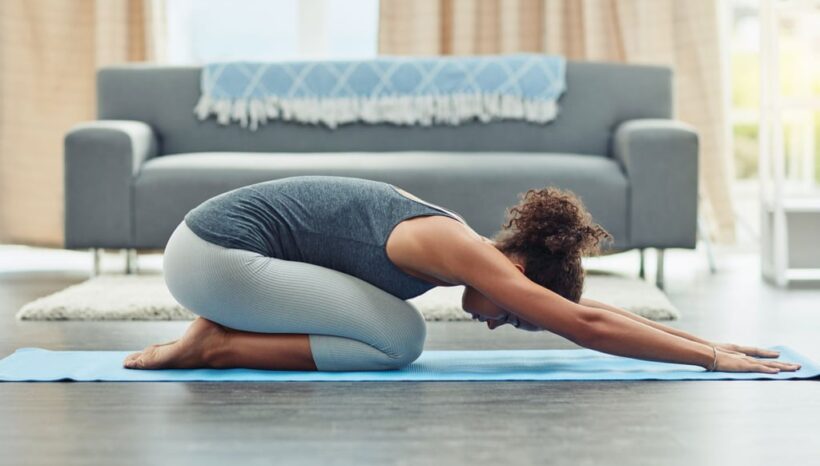
When you think of yoga, the first thing that probably comes to your mind is waking up in the morning and doing some active poses to wake your mind and body. You don’t have to restrict your practice to the morning time, though. There is evening yoga for beginners that you can do at home.
Why would you want to do yoga before bed? There are loads of benefits to nighttime yoga for beginners. You usually use all the calm and energy that you get in your morning practice in interacting with the world.
Evening yoga for beginners is the time you get to savor your practice and enjoy the benefits for yourself. We have examined the advantages of bedtime yoga for beginners below.
Advantages of Bedtime Yoga for Beginners
The world today is a busy place, with everyone always having something to do. These things often follow us to bed at night, making it hard to sleep deeply. You can shed these weights and sleep better with an evening yoga sequence for beginners.
You can enjoy these advantages even with a quick evening yoga for beginners. Some of the things you gain from an evening yoga routine for beginners are:
- It helps to reduce the symptoms of insomnia. You would find it easier to fall asleep or go back to sleep when you wake at night.
- Evening yoga helps you lose weight. Yoga promotes a state of mindfulness that makes you more conscious of what you eat.
- There is evening yoga for better sleep rituals that help you sleep better and improves the quality of life. These practices work better than drugs can.
- Your muscles and body are usually more hydrated and loose in the evening, making it easier for you to enjoy a deep stretch. These stretches help you to let go of any tension in your body – this reason is why evening yoga for seniors helps.
- Evening yoga also helps you calm your nerves. At this time of the day, your body is still racing from the stimulations of the day. A 10-minute evening yoga for beginners practice can help you calm down.
- Yoga is a peaceful and serene practice that helps you shed off stress. Evening practice will help you let go of any stressful occurrence during the day, putting you in a better state for the night.
- Both morning and evening yoga for beginners is an opportunity to get some ‘me-time.’ All you have to do is let the people around you understand your routine, and you can be left alone to meditate and practice at this time.
Now you know all the advantages that you stand to gain when you carve out a little time in the evening to practice yoga. You might be wondering what asanas and poses you can take to achieve these results, as not all poses are suitable for evening yoga for beginners. We have highlighted evening poses that you can try to tap into these benefits.
Evening Yoga For Beginners By Benefits
Morning yoga practice helps you stimulate your mind and prepare for the day ahead. An evening yoga practice has a different effect. It enables you to relax, calm your nerves, reduces the ‘monkey brain’ effects of a long day, and unwind for sleep.
You might have guessed that the poses for this hour of practice are not the hot yoga towel or super active kind, and you will be right. Evening yoga for beginners entails restorative, gentle yoga poses that help you breathe deeply and prepare for sleep.
We have highlighted some poses that you should try for your evening routine as a beginner below. You can choose to do only the poses that focus on the benefits you want to gain or do them all together in a sequence.
If you have any trouble with achieving any of the poses at home, you can sign up for evening yoga classes for beginners. You can search for ‘evening yoga for beginners near me’ if you don’t know where to find one.
Evening Yoga For Weight Loss
While weight loss is not the primary goal of yoga practice, it can help you lose weight and maintain your weight. Evening yoga for weight loss stimulates your parasympathetic nervous system, known as the ‘rest and digest system.’
This stimulation helps massage your digestive system, ensuring the food you have eaten digest faster. You should, however, be careful not to do any poses that will work up your digestive system too much, leading to adverse effects.
Some of the poses that you should try out to enjoy this benefit are Triangle Pose (Trikonasana), Downward Facing Dog, Bow Pose, Bridge Pose, Seated Spinal Twist (Ardha Matsyendrasana), and Pigeon Pose. The twists will also help if your goal is evening yoga for belly fat.
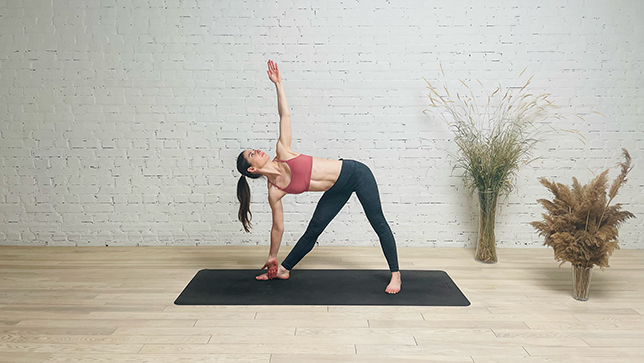
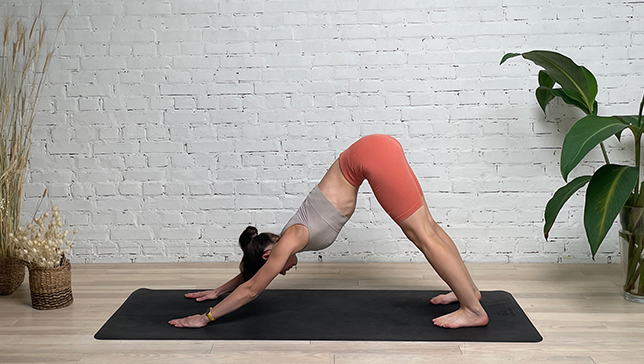
Downward Facing Dog Pose or Adho Mukha Svanasana in Sanskrit (Adho means 'downwards', Mukha 'face', and Svana means 'dog') is a foundational yoga pose that is often used as a transitional pose between other yoga asanas. Downward Facing Dog position provides a great stretch and strengthens the entire body, especially the arms, shoulders, hamstrings, calves, and spine. It can also help to calm the mind and relieve stress. Adho Mukha Svanasana is considered a base pose as Downward Facing Dog Pose Variations can be derived from this pose. This is a great pose to boost energy in the body and hence can be included in flow yoga sequences.
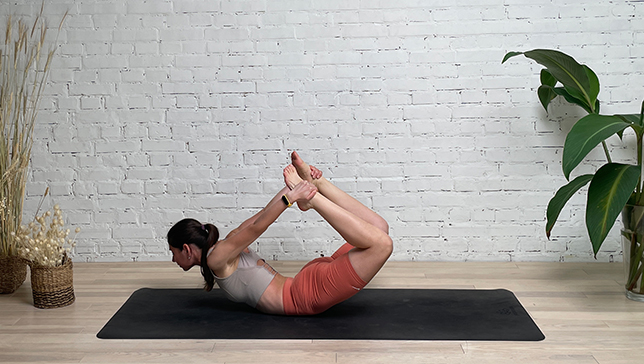
Bow Pose or Dhanurasana in Sanskrit ('Dhanu' means 'bow', whereas 'asana' means 'pose' or 'posture') is a backbending yoga posture that resembles a bow when practiced.
This powerful pose works on all the parts of your back simultaneously. The balancing of the entire body on the lower abdomen makes the body look like a powerful and strong bow. This beautiful pose brings all the stretch that is needed to the entire back and works wonders on the abdominal muscles.
Bow Pose is considered a base pose as bow pose variations can be derived from this pose. Bow Pose helps boost energy in the body and hence can be included in flow yoga sequences.
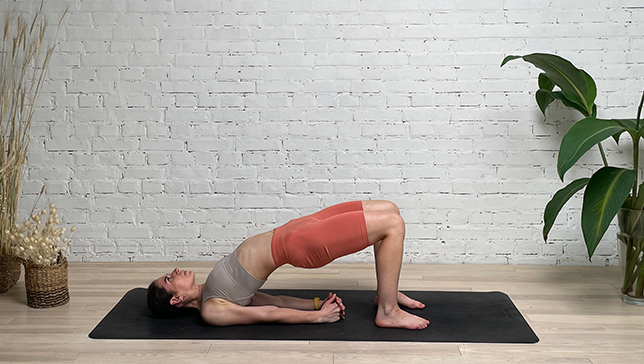
Bridge pose, also known as Setu Bandhasana or Setu Bandha Sarvangasana in Sanskrit ('setu' means 'bridge', 'bandha' means 'bind' or 'lock', 'sarvanga' means 'all limbs' or 'the whole body', and 'asana' means 'pose'), is a yoga pose that strengthens the legs, hips, and back muscles, as well as opens up the chest and shoulders. Here in Setu Bandhasana the entire spine is so beautifully curved and away from the floor/mat, which looks like a bridge. This asana is rather multifaceted. It combines the elements of a backbend, inversion, supine neck flexion, and a heart opener. Simultaneously, it brings focus to the lower body, strengthening ankles, thighs, glutes, and hips. Additionally, it stretches and tones the abdominal muscles, which in turn results in a more stable core and improved digestion. Considering the plethora of benefits it provides, it would be a wise choice to include it in your daily practice. Setu Bandha Sarvangasana is a beginner-level backbending yoga pose. It is considered a base pose as bridge pose variations can be derived from this pose. Bridge Pose helps boost energy in the body and hence can be included in different yoga sequences.
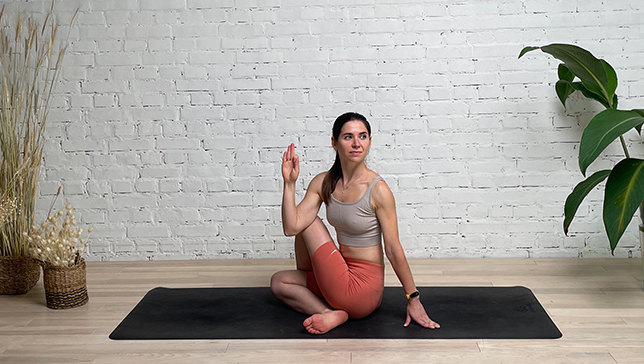
Half Lord of the Fishes Pose or Ardha Matsyendrasana, is named after the great yogi Matsyendranath who founded Hatha Yoga. The English name, Half Lord of the Fishes Pose, comes from the Sanskrit words 'ardha' = 'half', 'matsya' = 'fish', 'eendra' = 'king'. This yoga pose has other variations and can be referred to as Half Spinal Twist Pose or Vakrasana (which means twist).
This yoga pose usually appears as a seated spinal twist with many variations and is one of the twelve basic yoga poses (asanas) in many systems of Hatha Yoga. In this yoga pose the spine gets its maximum twist at the upper back with the thighs placed over each other and with the support of the arms the torso gets its twist.
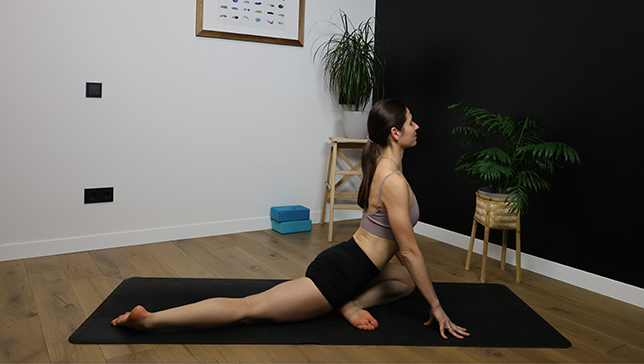
Pigeon Pose, Half Pigeon Pose, Eka Pada Kapotasana, or simply Kapotasana in Sanskrit (eka, meaning "one," pada, meaning "foot" or "leg," raja, meaning "king," kapota, meaning "pigeon," and asana, meaning "pose.") is named after a great yogic master Kapota.
Half Pigeon Pose is a challenging pose and comes under the category of Intermediate Level Poses. This asana helps practitioners to better open their hips, improve their backbend and stretch their torso preparing the whole body for more complex poses like Eka Pada Rajakapotasana A and B.
Evening Yoga For Relaxation And Better Sleep
Evening yoga for sleep is a buildup of all the poses you do in your routine. You can also incorporate some breathing exercises in your evening yoga for relaxation rituals for better results.
For evening relaxation yoga for beginners, you can start with the Easy Seated Pose, then the Lord Of The Fishes Pose. You should also add the Happy Baby Pose to your sequence, ending with the Corpse Pose (Savasana).
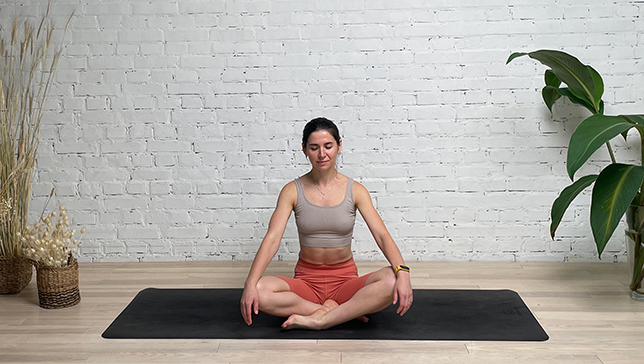
Easy Pose or Sukhasana from the Sanskrit word ‘Sukha’ meaning ‘Pleasure’ and 'Asana' means 'Pose', is a beginner-level restorative and meditative pose. Easy Pose is done with the crossing of the legs in the simplest form, unlike other meditative poses. This posture is excellent for meditation, and pranayama. It also works well to bring the mind and breath under control at the beginning or at the end of a yoga class. Sukhasana is considered a base pose as Easy Pose variations can be derived from this pose. It's a warm-up yoga pose to prepare the body for more intense yoga poses or flows.

Half Lord of the Fishes Pose or Ardha Matsyendrasana, is named after the great yogi Matsyendranath who founded Hatha Yoga. The English name, Half Lord of the Fishes Pose, comes from the Sanskrit words 'ardha' = 'half', 'matsya' = 'fish', 'eendra' = 'king'. This yoga pose has other variations and can be referred to as Half Spinal Twist Pose or Vakrasana (which means twist).
This yoga pose usually appears as a seated spinal twist with many variations and is one of the twelve basic yoga poses (asanas) in many systems of Hatha Yoga. In this yoga pose the spine gets its maximum twist at the upper back with the thighs placed over each other and with the support of the arms the torso gets its twist.
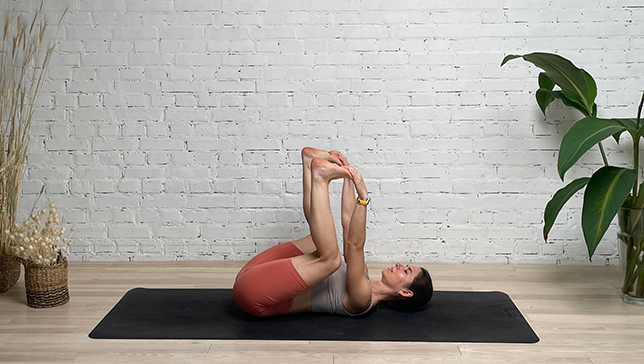
Happy Baby Pose or Ananda Balasana in Sanskrit (‘Ananda’ means ‘Happy’ and ‘Bala’ means a ‘Baby’) is an excellent grounding pose. Interestingly, it is also called the Dead Bug Pose, because of the position that the body takes up while performing this pose.
This yoga pose is considered one of the restorative poses which can be done for better sleep and full body relaxation. Apart from that the pose stretches the inner groins and the back spine, thus Ananda Balasana works as a soft hip opener.
Happy Baby Pose is considered a base pose as happy baby pose variations can be derived from this pose.
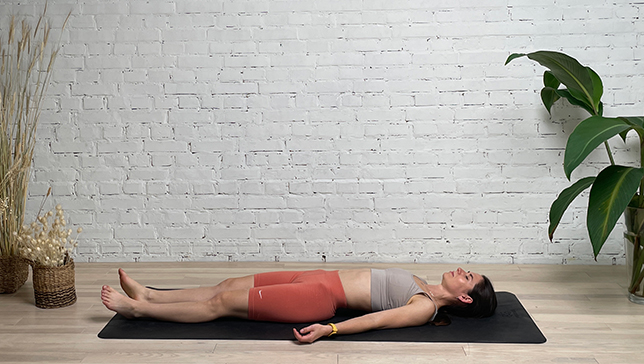
Verse 32 of the first chapter of the Hatha Yoga Pradipika states: ‘Lying upon one’s back on the ground at the full length like a corpse is called Savasana. This removes the fatigue caused by the other yoga poses and induces calmness of mind’. In Sanskrit ‘Sava’ means 'corpse' and 'asana' means 'pose' thus the name of the pose in English is Corpse Pose.
In Corpse Yoga Pose, the objective is to imitate a corpse by keeping the body still. By remaining motionless for some time and keeping the mind still while you are fully conscious, you learn to relax. This conscious relaxation invigorates and refreshes both body and mind.
This apparently easy posture is one of the most difficult to master, irrespective of the level of yoga practice or body flexibility.
Evening Yoga For Hips
If you spend a lot of time seated during the day, evening yoga for hips stretch and relaxation is essential. Evening yoga can help you relieve hip pain, making it easier for you to sleep and feel rejuvenated.
Some of the poses that you can try out to gain this effect are Garland Pose, Sphinx Pose, Goddess Pose (Supta Baddha Konsasana), and Reclined Butterfly Pose.
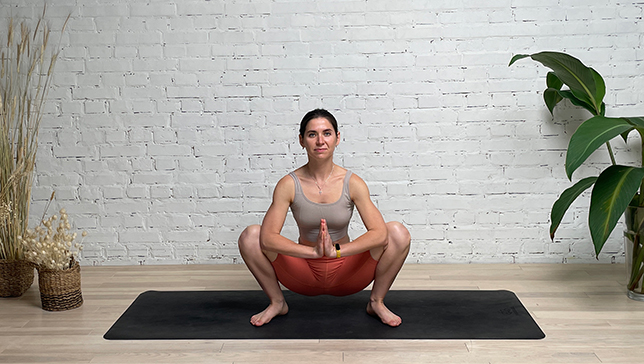
Garland Pose or Malasana is a very basic pose and should come naturally to all. But with modern comfort and habits, the simple bending of the knee and sitting on our feet has become a great challenge to most of us. Malasana brings back the most simple way of using the lower back and the knees to squat on the floor which otherwise should come naturally.
Garland Pose works wonders on the digestive organs and this is done by the simple method of sending apana (one of the five vital Vayus as per Yoga) downwards and thus bringing a strong Muladhara (one of the Chakras in the human body as per Yoga Sutras), which is the root of the spine.
Garland Pose is considered a base pose as garland pose variations can be derived from this pose. Garland Pose helps boost energy in the body and hence can be included in flow yoga sequences.
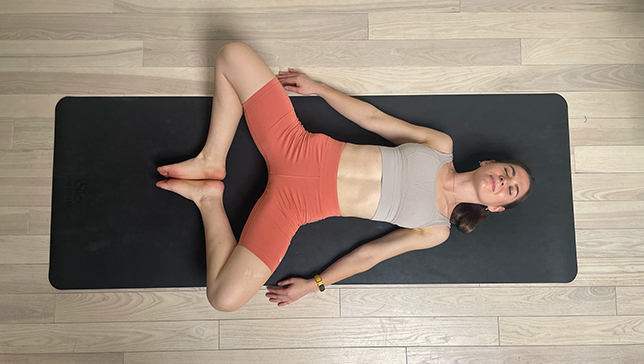
Reclining Bound Angle Pose or Supta Baddha Konasana in Sanskrit (‘supta’=’reclined’, ‘baddha’= ‘bound’, ‘kona' = ‘angle’ or ‘split’ and ‘asana’=’posture’. This pose comes under the category of restorative yoga poses, where while practicing yoga practitioner is more conscious of the body in order to renew energy and calm the nervous system. Generally, this pose concludes a yoga session to end in a beautifully relaxing way to gain control over the body and the mind. The supine position gives rest to the back and the hips and hence this pose is a must as part of every yoga session. Most relaxing yoga poses look easy but they require tremendous effort to bring the mind to focus on the body while the body is relaxed. This only comes through practice. Reclining Bound Angle Pose is considered a base pose as reclining bound angle pose variations can be derived from this pose. Reclining Bound Angle Pose helps boost energy in the body and hence can be included in flow yoga sequences.
Evening Yoga For Back
We often put our bodies in weird positions during the day. Evening yoga for the back involves stretches that help you straighten your back and relieves those kinks and aches from a wrong posture.
Some of the poses that you should try include the Bridge Pose, Child Pose, and Leg Up To The Wall Pose.

Bridge pose, also known as Setu Bandhasana or Setu Bandha Sarvangasana in Sanskrit ('setu' means 'bridge', 'bandha' means 'bind' or 'lock', 'sarvanga' means 'all limbs' or 'the whole body', and 'asana' means 'pose'), is a yoga pose that strengthens the legs, hips, and back muscles, as well as opens up the chest and shoulders. Here in Setu Bandhasana the entire spine is so beautifully curved and away from the floor/mat, which looks like a bridge. This asana is rather multifaceted. It combines the elements of a backbend, inversion, supine neck flexion, and a heart opener. Simultaneously, it brings focus to the lower body, strengthening ankles, thighs, glutes, and hips. Additionally, it stretches and tones the abdominal muscles, which in turn results in a more stable core and improved digestion. Considering the plethora of benefits it provides, it would be a wise choice to include it in your daily practice. Setu Bandha Sarvangasana is a beginner-level backbending yoga pose. It is considered a base pose as bridge pose variations can be derived from this pose. Bridge Pose helps boost energy in the body and hence can be included in different yoga sequences.
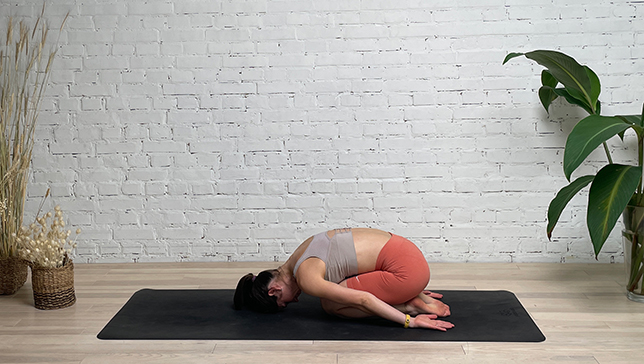
Child’s Pose in Sanskrit (‘Bala’, means ‘child’, 'asana' means 'pose'). Balasana or Child’s Pose is generally practiced at the end of an intense yoga sequence where the connection of the breath and the movement of the body would have been lost. The practice of Balasana concluding such a sequence, allows one to come to peace with the body with the connection of the breath. No doubt all yoga poses should lead to the connection of the breath and the body, but certain poses are challenging where the chest and the abdomen are compressed or pulled, creating uneasiness with the breathing. With Balasana, the spine remains relaxed in a forward fold and forces one to focus on breathing with the compressing of the abdomen and the chest towards the tummy. On the other hand, Balasana can be used purely as a restorative pose to heal patients with severe backaches, and insomnia, treat blood pressure, or just simply bring stress levels down. Child Pose is considered a base pose as child pose variations can be derived from this pose. Child Pose helps boost energy in the body and hence can be included in different yoga sequences. Child Pose is considered a warm-up and restorative yoga pose to prepare or restore the body before or after more intense yoga poses.
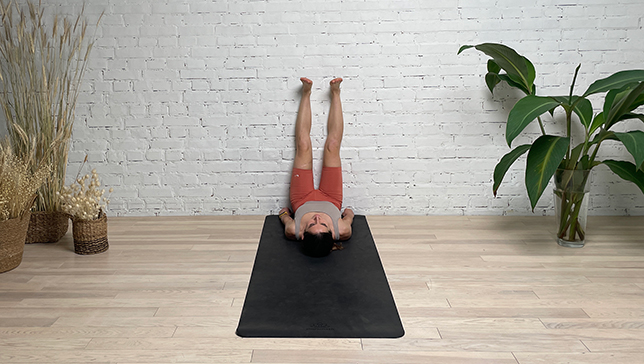
Legs Up the Wall Pose or Viparita Karani in Sanskrit (term that refers to the ‘action of inverting’). Thus it is more of a general action rather than an asana and hence the name does not end with ‘asana’. Viparita Karani is an inversion under the category of shoulderstand poses, but is easier to hold for extended periods of time. It is also considered as a restorative pose and hence releases tension in the body and mind.
Legs Up The Wall Pose is considered a base pose as legs up the wall pose variations can be derived from this pose.
Whether you do evening yoga for better sleep or any other benefits, these poses will help you. The movements are all suitable for evening yoga for beginners at home. You can also enroll in evening yoga classes for beginners near you if you don’t want to stay at home.
Frequently Asked Questions
Yes, bedtime yoga is good for your body. It helps you relax, sleep better, and lose weight. You should, however, chose slow types of yoga such as yin or Hatha. Hot yoga or other active yoga might end up keeping you awake instead of helping you sleep.
Experts recommend that you do yoga two to three hours before you plan to sleep in the evening. However, you can do it at any time that is convenient for you.
Slow yoga has the most relaxing yoga poses. Restorative yoga will help you relax better than hot or vinyasa yoga. Simple poses like easy pose, straight forward bend, rabbit pose, corpse pose, and plow pose will get you relaxed.
Yes, you can do Kapalbhati in the evening. However, ensure you do it on an empty stomach. You can practice it at sunset or two to three hours after eating.
Stay on Topic
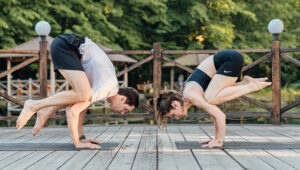
A majority of those who practice yoga do it as an individualistic practice and gain...

As we get older and take some of the stress that life throws our way,...

Starting your day off by connecting your body and mind is the most energizing and...

Whether you are looking to get in shape, or simply just improve your overall health...


